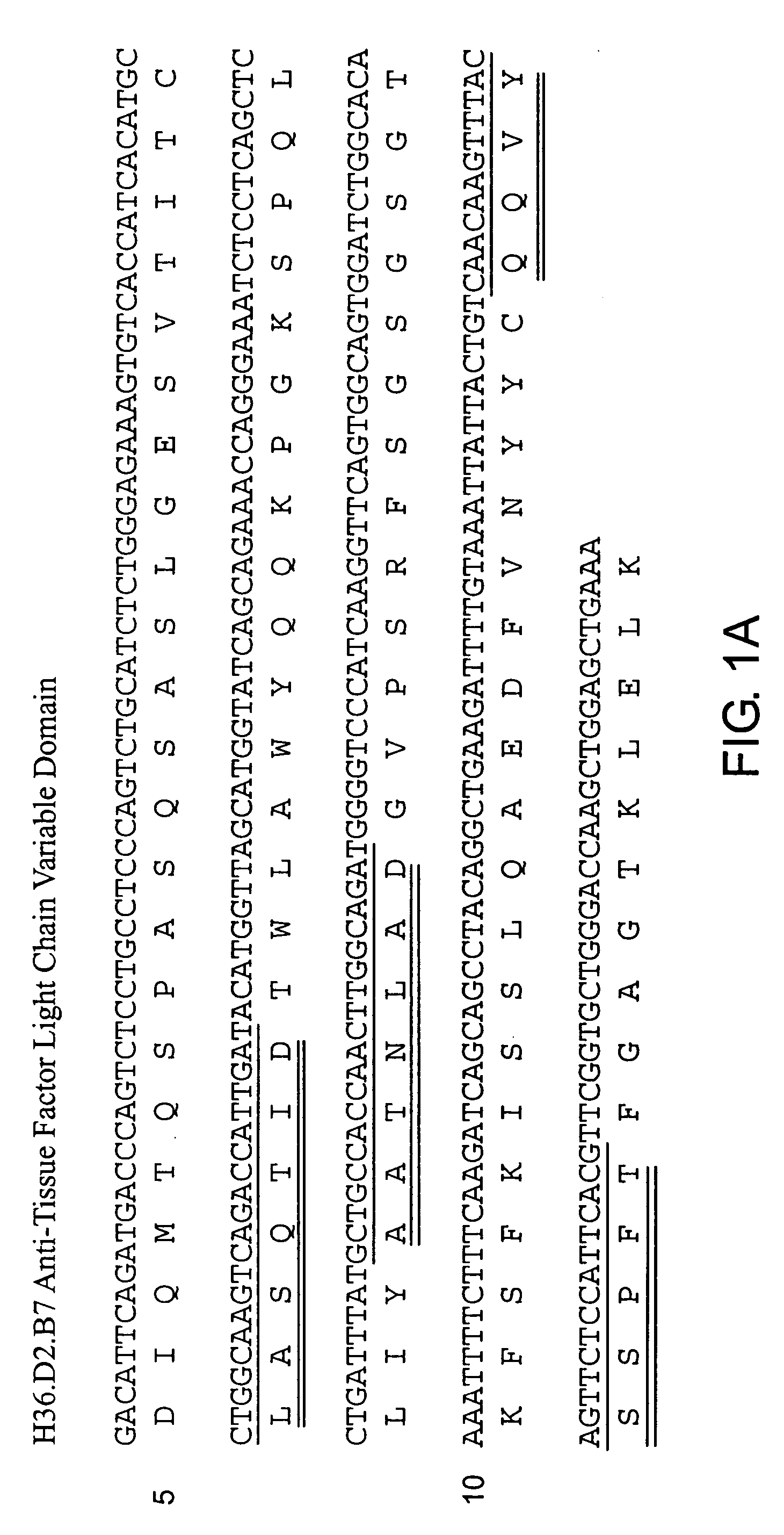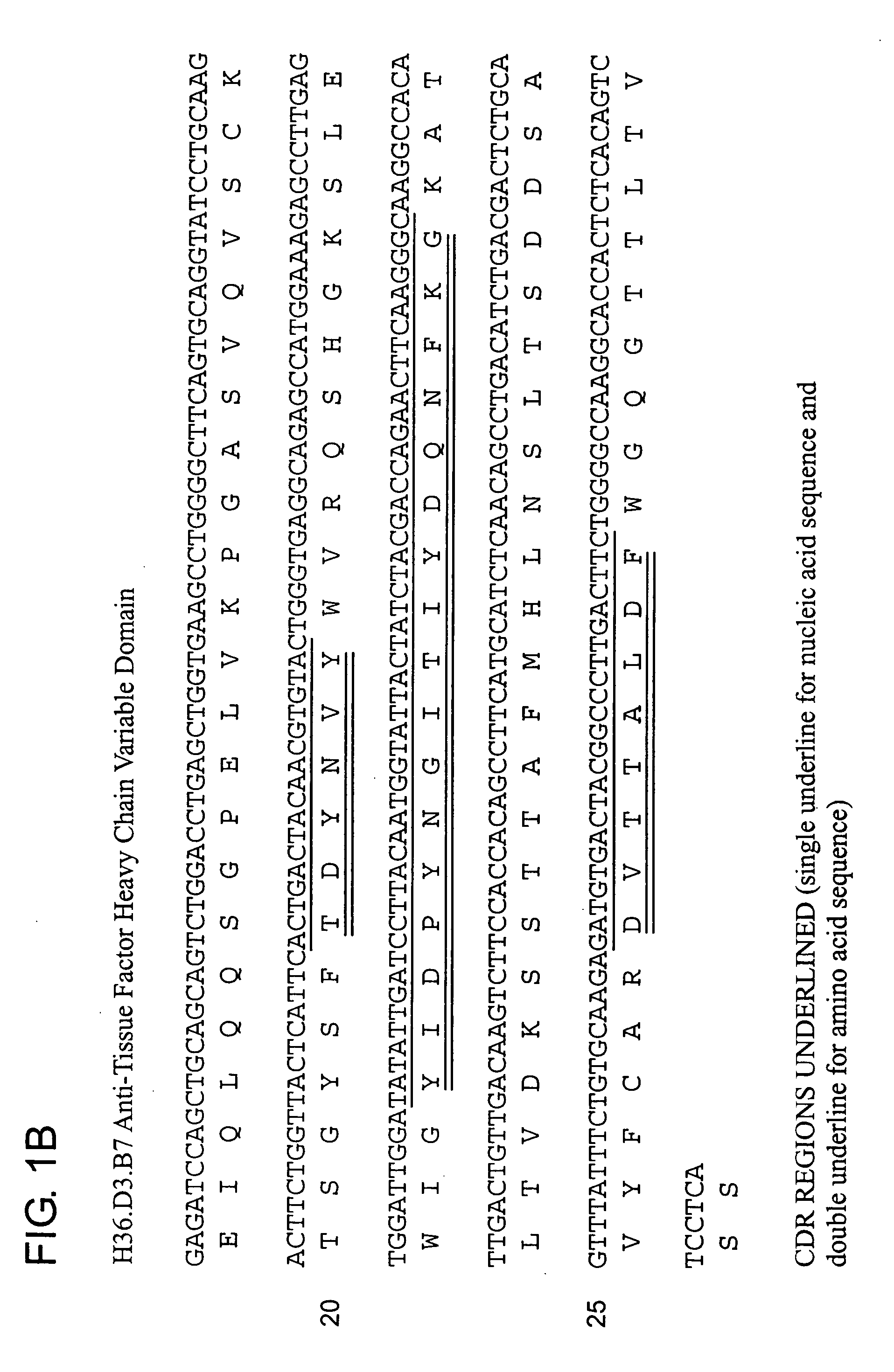Compositions and methods for treating coagulation related disorders
a technology for coagulation related disorders and compositions, applied in the field of compositions and methods for treating coagulation related disorders, can solve the problems of achieve the effects of preventing or treating certain inflammatory diseases, and reducing undesired activation of blood coagulation
- Summary
- Abstract
- Description
- Claims
- Application Information
AI Technical Summary
Benefits of technology
Problems solved by technology
Method used
Image
Examples
example 1
Humanization of Anti-Tissue Factor Antibody
[0136] The description of how to make and use a particular murine antibody called H36.D2 (sometimes also called H36 as discussed above) is described in U.S. Pat. Nos. 5,986,065 and 6,555,319. The present example shows how to make and use a humanized version of that antibody. A humanized H36 antibody has a variety of uses including helping to minimize potential for human anti-mouse antibody (HAMA) immunological responses. These and other undesired responses pose problems for use of the H36 antibody in human therapeutic applications.
[0137] A. Preparation of Chimeric Anti-Tissue Factor Antibody (cH36)
[0138] The H36 antibody described previously is an IgG2a murine antibody. H36 was first converted to a mouse-human chimeric antibody for clinical development. To do this, the heavy and light chain genes for H36 were cloned (see U.S. Pat. No. 5,986,065). The heavy chain variable domain was fused to a human IgG4 constant (Fc) domain and the light...
example 2
Expression and Purification of Humanized Anti-TF Antibodies
[0187] The partially humanized or fully humanized LC and HC clones were cloned into expression vectors. The plasmid tKMC18 was used to express LC mutants fused to human kappa chain, and pJRS 355 or pLAM 356 vector was used to express HC mutants fused to Fc of human IgG1 or IgG4. Some combinations of the HC and LC clones were then co-transfected into COS cells. The transiently expressed IgGs in COS cells were assayed for the whole IgG production and binding to TF by ELISA. For disclosure relating to these particular vectors see the published U.S. patent application number 20030190705 and references cited therein.
[0188] The final fully humanized forms of the anti-TF heavy and light variable domains (combination of HC08 and LC09) were cloned into what is referred to as a Mega expression vector (pSUN34, see FIG. 2) and transfected into CHO and NSO cells for IgG expression. Stably transfected cell lines producing the IgG4κ or I...
example 3
Septic Shock Model in Rhesus Monkeys
[0195] In this model, septic shock was induced by infusion of live E. coli, a gram-negative bacterium (see Taylor et al., J. Clin. Invest. 79:918-825 (1987)) in rhesus monkeys. The shock induced by E. coli causes activation both coagulation and inflammation, ultimately leading to death. The ability of an anti-TF antibody of the present invention to prolong the survival times of rhesus monkeys treated with live E. coli was examined using the rhesus model of septic shock described by Taylor et al., supra. Rhesus monkeys weighing 3-5 kilograms were fasted overnight before study and immobilized the morning of the experiment with ketamine hydrochloride (14 mg / kg, intramuscularly). Sodium pentobarbital was then administered in the cephalic vein through a percutaneous catheter to maintain a light level of surgical anesthesia (2 mg / kg initially and with additional amounts approximately every 20 to 45 minutes for 6 hours). A femoral vein was exposed asept...
PUM
| Property | Measurement | Unit |
|---|---|---|
| dissociation constant | aaaaa | aaaaa |
| prothrombin time assay | aaaaa | aaaaa |
| molecular mass | aaaaa | aaaaa |
Abstract
Description
Claims
Application Information
 Login to View More
Login to View More - R&D
- Intellectual Property
- Life Sciences
- Materials
- Tech Scout
- Unparalleled Data Quality
- Higher Quality Content
- 60% Fewer Hallucinations
Browse by: Latest US Patents, China's latest patents, Technical Efficacy Thesaurus, Application Domain, Technology Topic, Popular Technical Reports.
© 2025 PatSnap. All rights reserved.Legal|Privacy policy|Modern Slavery Act Transparency Statement|Sitemap|About US| Contact US: help@patsnap.com



